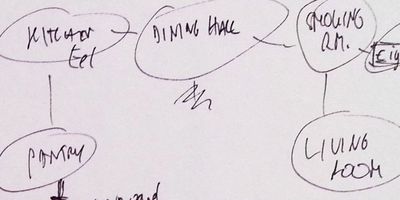About twenty years ago, I started writing an essay about solving adventure games that quickly evolved into a book when the scope grew and grew while I was structuring it. It never approached any semblance of a finished book, but I always kept working on it. At the moment, I’m not sure if it will ever be finished, but maybe the introduction will be of interest to some people. This is a work in progress, of course, so some parts of it may change later on.
I might publish other chapters from the book as work-in-progress on this site, and maybe that will keep me interested enough to write more of it. But as usual: we’ll see.
Solving adventures – Introduction
In every adventure game, there comes a point when we get stuck. There’s no way how the game can go on: we’ve tried everything, we’ve racked our brains. This is it, we’re at a dead-end. Sometimes it starts innocently enough, with a couple of straight-forward combination puzzles and one or two satisfying logic twisters thrown in – at other times it is hell from the beginning.
So why are we doing it?
There is a certain sense of achievement involved in solving a puzzle that other diversions simply cannot provide. Everyone has experienced how oddly fulfilling it can be to add the last missing letters in a cross-word puzzle, and every reader of this book will know how much more satisfying it is to finally reach a new part of a game after working through a series of puzzles.
While many modern games have puzzle elements, and some are indeed wholly based on puzzles, the “classic” adventure games of old are something completely different, both in scope and the general feeling of playing them. And while most discussions in this book are equally valid for all kinds of adventure games, they will concentrate on text adventure games as the most classic of them all.
Text adventures used to be a very successful genre, if short-lived. The first game was written around 1974, and the first commercial games began to emerge in 1978. Companies such as Adventure International (who published the first commercial adventure game Adventureland), Infocom (for many the definitive adventure publisher, with 34 text adventures to their credit), Sierra On-Line or the British Level 9 were founded on text adventure games.
In the 1980s, an estimated 2,000 games came out (give or take a few hundred), with some being available for almost every computer and on every medium, and others only on cassette tape and for a particular system. Most games were written in English, but there were also titles in other languages such as French, German, Spanish, Dutch and Japanese. Graphics have played a part almost from the beginning (Mystery House, the first game with graphics – and appropriately sparse text – was published as early as 1980), but with the hardware limits of the time, were mostly regarded as a distraction. Only with the new capabilities of the 16-bit computers that hit the market in late 1984, graphics started to become an alternative to text descriptions. In conjunction with the new story-telling techniques introduced in Maniac Mansion in 1987, the point-and-click adventure game began to rise, and quickly to displace the text adventure. Indeed, whereas 1987 was still a major year for the text adventure market of the time, in 1989 (when the last wave of Infocom adventures hit the market) text games were already widely regarded an anachronism, and by 1993 they were a thing of the past, as the last two companies announced they would cease to publish text adventures. There was a brief reemergence in the late 1990s tied to the Dotcom hype, but even though names like Michael Berlyn and Marc Blank of Infocom fame were attached to this phase, it only amounted to less than a dozen commercial games.
In the mid-80s, an amateur scene began to form, as adventure games were comparatively easy to program and most computer systems came with integrated BASIC interpreters. Additionally, The Quill, which enabled its users to write simple adventure games, appeared in 1983, and GAGS, ADL and AdvSys, early non-commercial systems for writing adventure games, followed in 1985 and 1987, respectively. Those systems relied on fixed game mechanics that allowed quite complex games, but were still limited – games like Infocom’s Suspended or Melbourne House’s The Hobbit would have been difficult if not impossible to design in them. This changed in 1988 when Michael J. Roberts’ TADS, the Text Adventure Development System, came out, followed in 1993 by Inform, developed by Graham Nelson. With these two powerful systems (and a slew of others in their wake, too many to list here), there remained almost no limits to writing text adventure games, and so these games enjoyed a new popularity in certain circles. As a case in point, the IF Archive, a public collection of most text games ever created, contains more than a thousand non-commercial games in addition to many formerly commercial ones.
A quick note: in recent years, the term “interactive fiction” has largely replaced “text adventure”, and indeed, the art form has changed to embrace a wider variety of presentations and content. Every year, many works come out that can be classified more as interactive literature than as games. These pieces of fiction, while an important part of the form, are not the subject of this book, and the phrasings in the other chapters reflect that fact.
While many text adventures are focused on a story that is told by overcoming obstacles, there are also those that simply present one obstacle after another. All of them do have in common that they are meant to entertain – and being stuck in a game tends to take the entertainment out of it.
This book aims to help with this problem. While there have been lots of solution guides, and many guides to designing adventure games, this is the first attempt, as far as I am aware, at providing a systematic method to solving them.
Be that as it may, if it can help any reader to get past a particularly difficult point in a game, it has reached its goal. And with that, I wish you good luck!


Comments are closed.